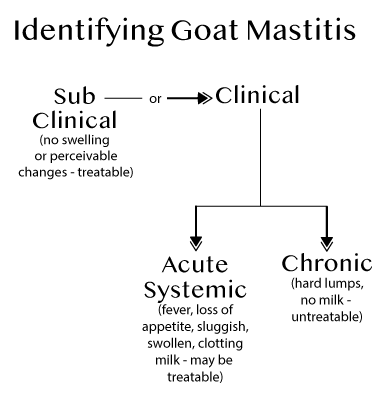Goat Mastitis
Mastitis will kill your goats. Here are the facts and how to prevent it.
One of the most difficult things about raising and breeding animals is a loss. All the care and love you put into them generally leads to happy and healthy animals, but even with the most diligent of care, you still lose some.
Ginny keeping warm in our makeshift infirmary
At Salt Ranch, we spoil our animals and treat them as an extension of our family. Early on when we first started our herd, we experienced our most difficult loss with Ginny.
Ginny came to us from a reputable source, but if I ever had an argument for sourcing registered goats, this might be it. She was an amazing animal. She had a difficult time taking to the bottle, and was the most timid of our kids, but was the most affectionate and attentive of all of our animals. She was a little lap goat! She was accidentally bred young when our buck broke through a fence. She developed an aggressive prolapse when she was pregnant; but had a healthy birth and two adorable bucklings. We weaned her kids and milked her twice a day and her milk was delicious.
When milking her, we diligently followed what limited information we could glean from our friends and online, making sure to clean her teats, discard the first few pulls from each side, milk her well but not all the way empty, and then dip in antiseptic after. She developed goat mastitis anyway and despite us and the vet trying everything, we lost her inside of a week. Here is what we learned. Stay with me – it is a bit technical.
Goat mastitis is the most common and expensive diseases to plague the dairy industry, yet we couldn’t find much about it online. If you don’t catch and treat it very early on, it is a killer 99% of the time. The good news is that with proper management and best practices, you can prevent MOST cases of mastitis in your goats!
Causes:
Physical injury – over milking, improperly maintained equipment, biting. (this is why so many dairy goats are dehorned.)
Stress
Bacteria (Staphylococcus, Streptococcus and E.coli being the main causative organisms.)
Viruses – they target the udders creating a “hard udder” (reduced milk production, firm udder with loose skin from swelling.)
Genetics
Identification:
The first step is understanding the types of mastitis.
Sub Clinical (treatable but can develop into clinical) OR Clinical
THEN two types of Clinical: Acute Systemic (treatable but can develop into chronic) OR Chronic (persistent and incurable)
Symptoms:
Subclinical: no swelling or perceivable changes in the milk.
Acute:
Sudden fever above 105 degrees and an accelerated pulse.
Loss of appetite
Slower movements
Visible depression
Swollen, Hard, Reddish, Hot or Sensitive mammary glands
Watery and yellowish milk
Flakey, clotting milk
Chronic: hard lumps in the udder and lack of milk production.
Diagnosis – you must test the milk using a microbiologic culture from samples of the milk. Ginny’s mastitis presented as acute and then moved quickly to chronic. If she was subclinical first, we didn’t know. There are two tests for mastitis (SCC – not recommended by some sources and CMT.) link to sources for kits. One tests somatic cell count, the other tests white blood cells. Testing during very early or late lactation can be difficult or unreliable. The ONLY source I could find that had any indication of frequency said test in the morning on days 20, 40, 60, 150 and 210.
Treatment:
This part was heartbreaking. We didn’t know what was happening, but if we had known what we know now, we would have done this… early identification and treatment is key. Think of mastitis in stages – if you detect it early on, your chances are higher.
Chronic mastitis is incurable (think of this as stage 4,) so if you have already seen symptoms, you are most likely not going to be successful treating mastitis. This doesn’t mean you shouldn’t try. She can still get better.
Separate your doe from the herd and put her in dry and completely clean conditions.
Call your vet
Dry off the affective half (stop milking) but continue to milk the other side (discard the milk.)
Apply infusion of 2% chlorhexidine solution twice a day for 10 days.
Administer antibiotics for 5-10 days (our vet provided us with prefilled syringes)
Glucocorticoids (from your vet) can be injected into the teat early on and has been reported to reduce swelling. Proceed with caution - there are some who believe that injecting anything into the teat can be fatal.
You can also use anti-inflammatory ointments to help to reduce swelling, just watch for tissue irritation.
That is really all you can do, so you feel for the most part helpless as you watch her fighting.
What we WISH we had known going into our first freshening.
Prevention:
Wound care. Mud is BAD. Water is your enemy. It’s not just inconvenient but causes a breeding ground for bacteria, can lead to foot rot, scald and abbesses which contribute further to ideal conditions for bacteria that causes mastitis. Be vigilant and treat any of these conditions.
Ensure your pens are clean and dry.
Change out bedding in kidding pens DAILY (or as much as possible) and disinfect.
Keep troughs and water buckets out of the bedding areas.
Provide a minimum stress environment for them (keep your bucks FAR away and make the does feel safe and calm) Sometimes having a buck is not the best idea.
Keep sterile milking techniques – click here to read our article about how to properly hand milk goats.
Shave or clip udders regularly to help keep them clean.
If udders are visibly dirty, clean with dry paper towels. If possible, avoid using water because it will travel down and into the teat possibly contaminating the opening.
If it is necessary to use water, use a disinfectant wash and dry the udder and teats before continuing.
Disinfect teats before and after milking by immersing teats in iodine or consider an aseptic solution of 1% iodophor or 4% hypochlorite and dry with a paper towel. This prevents any dirt from sticking to the teats.
Use gloves or wash hands thoroughly when milking, making sure to strip each teat 2 or 3 times and check for abnormalities before disposing.
Use a gel to protect the udders after milking. Consider antimicrobial Utility Gel
Clean and sterilize all equipment before each use.
Additional preventative measures for those with some experience:
Buy your goats from a reputable source and palpate the mammary glands to check for lumps and abnormalities. Do this again before breeding.
Cull any chronic goats from the herd.
Watch goats that have aborted as the bacteria is the same.
Test your herd for tuberculosis, caprine arthritis encephalitis, brucellosis, and leptospirosis.
It took a hard loss and a lot of research for us, but I hope that by sharing our story and arming others with the facts we can help others to never have to experience a loss like ours. I can say that when we were new with goats we were lost. There are so many conflicting opinions out there, and not a lot of hard facts. We hope to change that at Salt Ranch and arm our friends and followers with facts so you can make your own opinions.
Sources:
https://www.ncbi.nlm.nih.gov/pmc/articles/PMC7811533/
https://ssl.acesag.auburn.edu/pubs/docs/U/UNP-0102/UNP-0102-archive.pdf
https://vetericyn.com/blog/how-to-treat-mastitis-in-goats/
https://www.farmhealthonline.com/US/disease-management/goat-diseases/mastitis-in-goats/
https://edis.ifas.ufl.edu/publication/AN382
https://mysrf.org/pdf/pdf_dairy/goat_handbook/dg5.pdf
https://www.sciencedirect.com/science/article/pii/S0022030210005023
http://omaf.gov.on.ca/english/livestock/goat/news/dgg1308a1.htm
https://www.ncbi.nlm.nih.gov/pmc/articles/PMC8300097/




